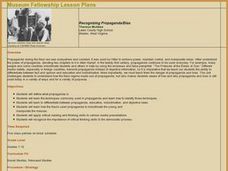Curated OER
In the Lead
High schoolers reflect upon questions of guilt and hatred in context of Holocaust, and compare/contrast meaning of loyalty or patriotism during Holocaust and today.
Curated OER
Diaries and Memoirs
Students analyze how personal diaries and memoirs record actual events, compare and contrast diaries and memoirs from the Holocaust, and engage in journal or diary writing as a way to explore one's own feelings and self.
Curated OER
Diaries and Memoirs
Seventh graders analyze how personal diaries and memoirs record actual events. In this World History lesson, 7th graders compare and contrast diaries and memoirs from the Holocaust. Students write as a way to explore one's own feelings...
Curated OER
Commemorative Plates
Young scholars research life of a child who was a victim in the Holocaust and create a commemorative plate for that child to display in the school.
Curated OER
It Can't Happen Here or Can It?: Peer Pressure, Prejudice and Intolerance
Students study the Holocaust and explore peer pressure, prejudice and intolerance.
Curated OER
Starvation in the Ghettos
Young scholars consider the lack of nutrition experienced in Holocaust ghettos. For this Holocaust lesson, students investigate the Nazi policy of starving people out of the ghettos through their food rationing program. Young scholars...
Curated OER
Social Studies - Concentration Camps -2
Eighth graders investigate the typical day in a concentration camp. In this Holocaust lesson, 8th graders read primary and secondary sources about the conditions of the camps. Students also conduct research about the Warsaw Ghetto,...
Curated OER
Oral History
Students explore cultural diversity, the difficulties of immigration, and lost cultures. They study historical events such as the Holocaust.
Curated OER
Inside the Warsaw Ghetto
Eighth graders examine the conditions of the ghettos during the Holocaust. In this World History instructional activity, 8th graders analyze the impact of the Jewish fighters during he Warsaw Ghetto Uprising. Students participate in a...
Curated OER
Epidemic, Plague, and Infection
Learners investigate the illness borne in concentration camps. In this Holocaust instructional activity, students participate in a simulation that requires them to consider how ailments became epidemics in concentration camps.
Curated OER
Population Density in the Ghettos
Young scholars examine population density in Jewish ghettos. In this Holocaust lesson plan, students calculate population density of cities around the world using the provided information. Young scholars then discuss the implications of...
Curated OER
Anne Frank Diorama
Students create a diorama of the Secret Annex in which Anne Frank and her family hid during the Holocaust. In this Anne Frank diorama lesson, students brainstorm a list of ideas about the Secret Annex. Students create the diorama using...
Curated OER
Introduction to the Holocaust: Appreciating Another Culture
Students explore the concept of cultural diversity. In this cultural diversity lesson, students read Molly's Pilgrim by Barbara Cohen and discuss cultural traditions. Students then research countries and cultures and share their findings.
Curated OER
Book Talk: Holocaust
Students prepare and deliver book talks. For this Holocaust lesson, students read a book regarding the Holocaust, take notes on it, and give a book talk based on the book. Students respond to the book talks by email.
Curated OER
Hiding Escape And Rescue
Students engage in a unit of literature study in order to focus upon the historical context of the holocaust. They read the literature in either whole works or partially depending on the teacher and answer the questions to measure...
Curated OER
Holocaust Word Search
In this History instructional activity, students identify and locate vocabulary terms that are related to the Holocaust. There are 38 words located in the word search.
Curated OER
Cartoon-Truth or Tale
Students examine Nazi propaganda. In this Holocaust lesson, students investigate the power of symbolism as they examine Nazi propaganda cartoons and then create their own cartoons using propaganda regarding current events of their choosing.
Teach With Movies
Learning Guide to: Schindler's List
Take your history class through Schindler's List with a learning guide, which offers an introduction to the film and a variety of discussion questions and related assignments. There are several useful resources in the sidebar, such as a...
Curated OER
A Look at Exclusion Through Improvisation
Building a realistic understanding of the trials Jews suffered during WWII isn't always easy. This plan employs student constructed dramatic freeze frame scenes to help build a deeper understanding of Jewish Ghettos, concentration camps,...
Curated OER
Recognizing Propaganda/Bias
Middle and high schoolers examine the uses of propaganda during the Nazi era. Using examples of propaganda used by Hitler, they discuss how it changed the thinking and ideas of people exposed to it. In groups, they identify how and why...
Curated OER
Anne Frank Quiz
Some very detailed questions are included in this quiz such as, "Between what hours of the day on August 4th, 1944 did an SS car pull up at the annex to arrest members?" Other questions are not so complex and focus on relationships of...
Curated OER
Unsent Letter: Characterization in Briar Rose
After completing Jane Yolen’s Briar Rose, class members assume the voice of Gemma and craft a personal letter to her granddaughter telling Becca how she feels about Becca’s actions and the discoveries at Chelmno. Complete directions for...
Curated OER
Vocabulary Strategy Instructional Routine: Maus I and II
Pogrom, schlepped, meshuga. Kapo, reich, Wehrmacht. As part of a unit study of Maus I and II, readers use a list-group-label (LGL) strategy for vocabulary drawn from Art Spiegelman's famous graphic novels. The focus of the activity is...
Curated OER
Stereotypes in The Diary of Anne Frank
Before reading Anne Frank's diary, discuss stereotypes with your class. This guide is a great prereading activity; pupils complete a list of incomplete sentences in order to showcase common stereotypes. Then, they complete the seven...

























